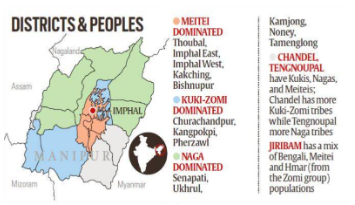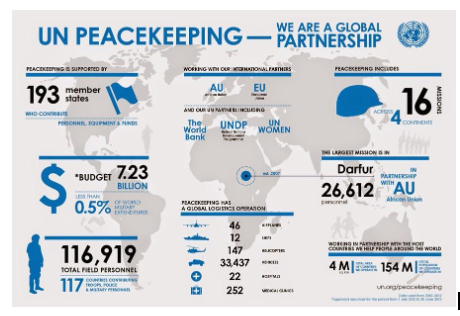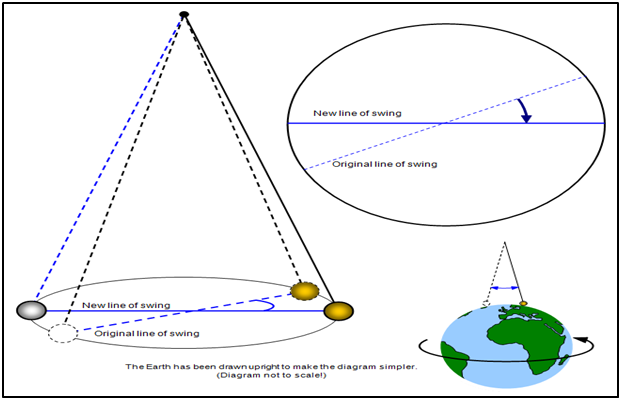
DAILY CURRENT AFFAIRS BITS
TOPIC – 1 – Comptroller and Auditor General of India (CAG)
A US Congressional Committee recently recommended strengthening Nato Plus by including India in the five-member grouping.
About Comptroller and Auditor General of India (CAG):
- CAG is the apex authority responsible for external and internal audits of the expenses of the National and state governments in the country.
- The Constitution of India provides for an independent office of the CAG in Chapter V.
- The CAG is mentioned in the Constitution of India under Article 148 – 151.
- Constitutional Provisions:
- Article 148broadly deals with the CAG appointment, oath and conditions of service.
- Article 149deals with duties and powers of the CAG.
- Article 150says that the accounts of the Union and of the States shall be kept in such form as the President may, on the advice of the CAG, prescribe.
- Article 151says that the reports of the CAG relating to the accounts of the Union shall be submitted to the President, who shall cause them to be laid before each House of Parliament.
- As per Article 279, Calculation of “net proceeds” is ascertained and certified by the CAG, whose certificate is final.
- Appointment and Terms of Service:
- As per Article 148 of the Constitution, there shall be a Comptroller and Auditor-General of India who shall be appointed by the President and can be removed from office only in the manner and on the grounds that a Judge of the Supreme Court is removed.
- He holds office for a period of six years or upto the age of 65 years, whichever is earlier.
- Functions of CAG:
- CAG audits the accounts related to all expenditure from the Consolidated Fund of India, Consolidated Fund of each state and UT’s having a legislative assembly.
- He audits all expenditure from the Contingency Fund of India and the Public Account of India as well as the Contingency Fund and Public Account of each state.
- He audits all trading, manufacturing, profit and loss accounts, balance sheets and other subsidiary accounts kept by any department of the Central Government and the state governments.
- CAG audits the receipts and expenditure of all bodies and authorities substantially financed from the Central or State revenues; government companies; other corporations and bodies, when so required by related laws.
- He audits the accounts of any other authority when requested by the President or Governor e.g. Local bodies.
- He advises the President with regard to prescription of the form in which the accounts of the Centre and States shall be kept.
- Reports by CAG: The CAG submits his audit reports relating to the accounts of the Centre to the President, who shall, in turn, place them before both the houses of Parliament. He submits 3 audit reports to the President-
- Audit report on appropriation accounts;
- Audit report on finance accounts;
- Audit report on public undertakings;
- He also submits his audit reports relating to the accounts of a State to the Governor, who shall, in turn, place them before the state legislature.
Authorities in US and Mexico recently appealed to the World Health Organization (WHO) to declare a public health emergency over a fungal meningitis outbreak.
About Meningitis:
- Meningitis is an inflammation (swelling) of the protective membranes covering the brain and spinal cord. These membranes are called meninges.
- The most common causes of meningitis are viral and bacterial infections. Other causes may include:
- cancer
- fungi
- drug-induced reactions
- Transmission: Infections that cause meningitis can be spread through sneezing and coughing.
- Symptoms:
- Common symptoms of meningitis are neck stiffness, fever, confusion or altered mental status, headaches, nausea and vomiting.
- Less frequent symptoms are seizures, coma and neurological deficits (for example hearing or vision loss, cognitive impairment, or weakness of the limbs).
- Types of meningitis caused by viruses or bacteria can have similar symptoms. Symptoms may be stronger in some types of meningitis than in others and require different treatment.
- Treatment and Prevention:
- Meningitis is a medical emergency. It is potentially fatal within 24 hours and requires urgent medical attention.
- Meningitis can vary in severity, appropriate treatment and care depending on the cause. Meningitis caused by bacteria requires immediate antibiotic treatment.
- Vaccines offer the best protection against common types of bacterial meningitis.
- Antibiotics for close contacts of those with meningococcal disease, when given promptly, decreases the risk of transmission
TOPIC – 3 – Senkakau Islands
Amid the rising tensions in the Indo-Pacific region, Japan Coast Guard (JCG) source recently revealed that a China Coast Guard (CCG) vessel has been navigating in Japan’s territorial waters around the Senkaku Islands.
About Senkaku Islands:
- Location:
- The Senkaku Islands are an uninhabited group of islands situated in the East China Sea.
- It is approximately 90 nautical miles north from the Yaeyama Islands in Japan’s Okinawa Prefecture and 120 nautical miles northeast of the island of Taiwan.
- They are also known as the Diaoyu Islands in Mainland China, the Diaoyutai Islands in Taiwan and the Pinnacle Islands by other observers.
- The islands comprise Uotsuri Island, Kuba Island, Taisho Island (also called Kumeakashima Island), Kitakojima Island, Minamikojima Island, Tobise Island, Okinokitaiwa Island, and Okinominamiiwa Island.
- Dispute: The islands are the focus of a territorial dispute between Japan and China and between Japan and Taiwan.
- Administration:
- They were never administered by any other country before Japan incorporated them into its territory in 1895.
- Currently, Japan administers and controls the Senkaku islands as part of the city of Ishigaki in Okinawa Prefecture
TOPIC – 4 – Sakhalin-1 Project
Oil and Natural Gas Corporation’s subsidiary, ONGC Videsh, recently said that oil output from the Sakhalin-1 project in Russia had bounced back to its plateau level of about 200,000 barrels per day (bpd) from zero.
About Sakhalin-1 Project:
- Location: The Sakhalin-1 oil and gas development project is located in the Okhotsk Sea, off the north-eastern coast of Sakhalin Island in the Russian Far East.
- It comprises three offshore fields namely Chayvo, Odoptu, and Arkutun-Dagi.
- It is operated by Exxon Neftegas (ENL), a subsidiary of Exxon Mobil which holds a 30% participating interest. The other partners of the project are the Japanese consortium Sakhalin Oil and Gas Development Company (SODECO, 30%), India’s state-owned ONGC Videsh (20%), and Russian oil company Rosneft (20%).
- The Sakhalin 1 project is estimated to hold approximately 2.3 billion barrels of oil and 17.1 trillion cubic feet (Tcf) in recoverable reserves.
ONGC Videsh Ltd (OVL):
- It is a Miniratna Schedule “A” Central Public Sector Enterprise (CPSE)of the Government of India and is the wholly owned subsidiary and overseas arm of Oil and Natural Gas Corporation Limited (ONGC).
- It comes under the administrative control of the Ministry of Petroleum and Natural Gas.
- The primary business of ONGC Videsh is to prospect for oil and gas acreages outside India, including exploration, development and production of oil and gas.
- ONGC Videsh is the second largest petroleum company of India, next only to its parent ONGC.
TOPIC – 5 – Spear Phishing
According to a recent report, as many as 53 per cent of organisations studied in India were victims of spear phishing in 2022.
About Spear Phishing:
- It is an email or electronic communications scam targeted towards a specific individual, organization or business.
- It is a targeted attempt to steal sensitive information such as account credentials or financial information from a specific victim, often for malicious reasons.
- This is achieved by acquiring personal details on the victim such as their friends, hometown, employer, locations they frequent, and what they have recently bought online.
- Working:
- A spear phishing email uses social engineering techniques to urge the victim to click on a malicious link or attachment.
- Additionally, the email will blatantly ask the recipient to respond urgently, such as transferring a specific sum of money or sending personal data such as a banking password.
- Because the emails are written in a highly familiar tone and refer to personal information about the recipient, victims mistakenly believe they know and trust the sender and respond to the request.
- Once the victim completes the intended action, the attacker can steal the credentials of a targeted legitimate user and enter a network undetected.
- This is the most successful form of acquiring confidential information on the internet, accounting for 91% of attacks.
TOPIC – 6 – KSS-III Batch-II Submarine
South Korea has recently come up with a special proposal to provide its advanced KSS-III Batch-II submarine to India.
About KSS-III Batch-II Submarine:
- The KSS-III, the largest submarine to ever be built by South Korea, is being developed in two phases, Batch-I and Batch-II.
- It is a series of diesel-electric attack submarines.
- KSS-III Batch-II is an advanced version of its predecessor in terms of combat management systems, firepower, and sonar capabilities.
- It is jointly developed by Daewoo Shipbuilding and Marine Engineering (DSME) and Hyundai Heavy Industries (HHI).
- Features:
- The submarine will be 89 metres long, 9.6 metres wide, and have a displacement of around 3,600 tonnes.
- The Batch-II series will be equipped with lithium-ion batteries, which will reportedly make it capable of cruising at higher speeds with a greater period of underwater endurance, life expectancy, and durability.
- Additionally, the submarines will be equipped with Air Independent Propulsion (AIP) technology that will allow them to operate without access to atmospheric oxygen.
- It will also be capable of carrying a crew of 50 members.
- It can fire missiles such as Hyunmoo-4-4 submarine-launched ballistic missiles (SLBM).
- The submarines can attain a maximum operating speed of approximately 20 knots and cruising range of 10,000 nmi.
- The navigation aids on board the submarine include an inertial navigation system (INS) and global positioning system (GPS)
TOPIC – 7 – Acinetobactor baumannii
A group of scientists recently discovered a new antibiotic that can kill a deadly superbug called Acinetobacter baumannii.
About Acinetobactor baumannii:
- Acinetobacter is a group of bacteria (germs) commonly found in the environment, like in soil and water.
- While there are many types, the most common cause of infections is Acinetobacter baumannii, which accounts for most Acinetobacter infections in humans.
- It is a Gram-negative bacteria that often displays multidrug resistance.
- It can cause infections in the blood, urinary tract, and lungs (pneumonia), or in wounds in other parts of the body.
- It can also “colonize” or live in a patient without causing infections or symptoms, especially in respiratory secretions (sputum) or open wounds.
- These germs are frequent causes of hospital-acquired infections, especially in intensive care units (ICUs).
- It is highly contagious.
Gram-Positive vs. Gram-Negative Bacteria:
- Gram-positive bacteria have cell walls made of a thick layer of peptidoglycan.
- The cell walls of gram-negative bacteria contain only a thin layer of peptidoglycan, but they also have an outer membrane that is absent in gram-positive bacteria.
- Gram staining is a technique that uses violet dye to distinguish between gram-positive and gram-negative bacteria.
- If the bacteria are gram-positive, the thick, peptidoglycan layer in their cell walls will retain the dye and they will stain violet.
- If the bacteria are gram-negative, the dye will leak out of the thin peptidoglycan layer, and the bacteria will stain red.
TOPIC – 8 – Neuralink
Elon Musk’s brain chip firm, Neuralink wins US approval for human study.
- Neuralink Corporation is an American neuro-technology company that is developing implantable brain–computer interfaces.
- Neuralink hopes to use its microchips to treat conditions such as paralysis and blindness, and to help certain disabled people use computers and mobile technology.
- The chips, which have been tested in monkeys, are designed to interpret signals produced in the brain and relay information to devices via Bluetooth.
- The company plans to use its microchips to treat conditions such as paralysis.
- Its initial aim was to start planting chips in human brains in 2020, in order to honour a pledge made the year before and it later vowed to get started in 2022.
- Mr Musk also suggested that the proposed technology could help ease concerns about humans being displaced by AI.
- Experts have cautioned that Neuralink’s brain implants will require extensive testing to overcome technical and ethical challenges if they are to become widely available.
A paralysed man from the Netherlands was able to walk simply by thinking about it, because of a system of implants which wirelessly transmit his thoughts to his legs and feet
TOPIC – 9 – GSLV-F12 & NVS-01
The GSLV-F12/NVS-01 mission was launched from the second launch pad at the Satish Dhawan Space Centre SHAR, Sriharikota.
- The Indian Space Research Organisation (ISRO) successfully placed the NVS-01 navigation satellite, weighing about 2232 kg, into Geosynchronous Transfer Orbit (GTO).
- The GSLV-F12 is the 15th flight of India’s GSLV and the 9th flight with indigenous cryostage.
- This is the 6th operational flight of GSLV with indigenous cryogenic stage.
- The NVS-01 carried navigation payloads L1, L5 and S bands.
- The satellite would ensure the continuity of navigational (NavIC) services and also provide new service in L1 band.
- Interestingly, for the first time, an indigenous atomic clock was flown in NVS-01.
An atomic clock is an extremely accurate type of clock which is regulated by the vibrations of an atomic or molecular system such as caesium or ammonia.
L1, L5 and S bands
- The GPS L1 band (1575.42 MHz) has turned to be the most important band for navigation purposes.
- The two sorts of services given by the Indian Regional Navigational Satellite System (IRNSS) satellites are Standard Positioning Service (SPS) and Restricted Service (RS).
- Both services will be given at two frequencies of L5 (1164.5 MHz) and S (2472.5 MHz) band.
TOPIC – 10 – Deep ocean currents in Antarctica
Deep ocean currents in Antarctica are slowing earlier than predicted.
- Antarctica sets the stage for the world’s greatest waterfall, where the action takes place beneath the surface of the ocean.
- Trillions of tonnes of cold, dense, oxygen-rich water cascade off the continental shelf and sink to great depths.
- This Antarctic bottom water then spreads north along the sea floor in deep ocean currents, before slowly rising, thousands of kilometres away.
- In this way, Antarctica drives a global network of ocean currents called the overturning circulation that redistributes heat, carbon and nutrients around the globe.
- The overturning is crucial to keeping the earth’s climate stable and is the main way oxygen reaches the deep ocean.
Recent findings
- There are signs this circulation is slowing down and it’s happening decades earlier than predicted.
- This slowdown has the potential to disrupt the connection between the Antarctic coasts and the deep ocean.
- Melting of Antarctic ice is disrupting the formation of Antarctic bottom water.
- The meltwater makes Antarctic surface waters fresher, less dense, and therefore less likely to sink.
- This puts the brakes on the overturning circulation.
- As the flow of bottom water slows, the supply of oxygen to the deep ocean declines.
- The shrinking oxygen-rich bottom water layer is then replaced by warmer waters that are lower in oxygen, further reducing oxygen levels.
Implications
- Ocean animals, large and small, respond to even small changes in oxygen.
- Deep-ocean animals are adapted to low oxygen conditions but still have to breathe.
- Losses of oxygen may cause them to seek refuge in other regions or adapt their behaviour.
- The overturning circulation carries carbon dioxide and heat to the deep ocean, where it is stored and hidden from the atmosphere.
- As the ocean storage capacity is reduced, more carbon dioxide and heat are left in the atmosphere.
- This feedback accelerates global warming.
- Reductions in the amount of Antarctic bottom water reaching the ocean floor also increases sea levels because the warmer water that replaces it takes up more space (thermal expansion).
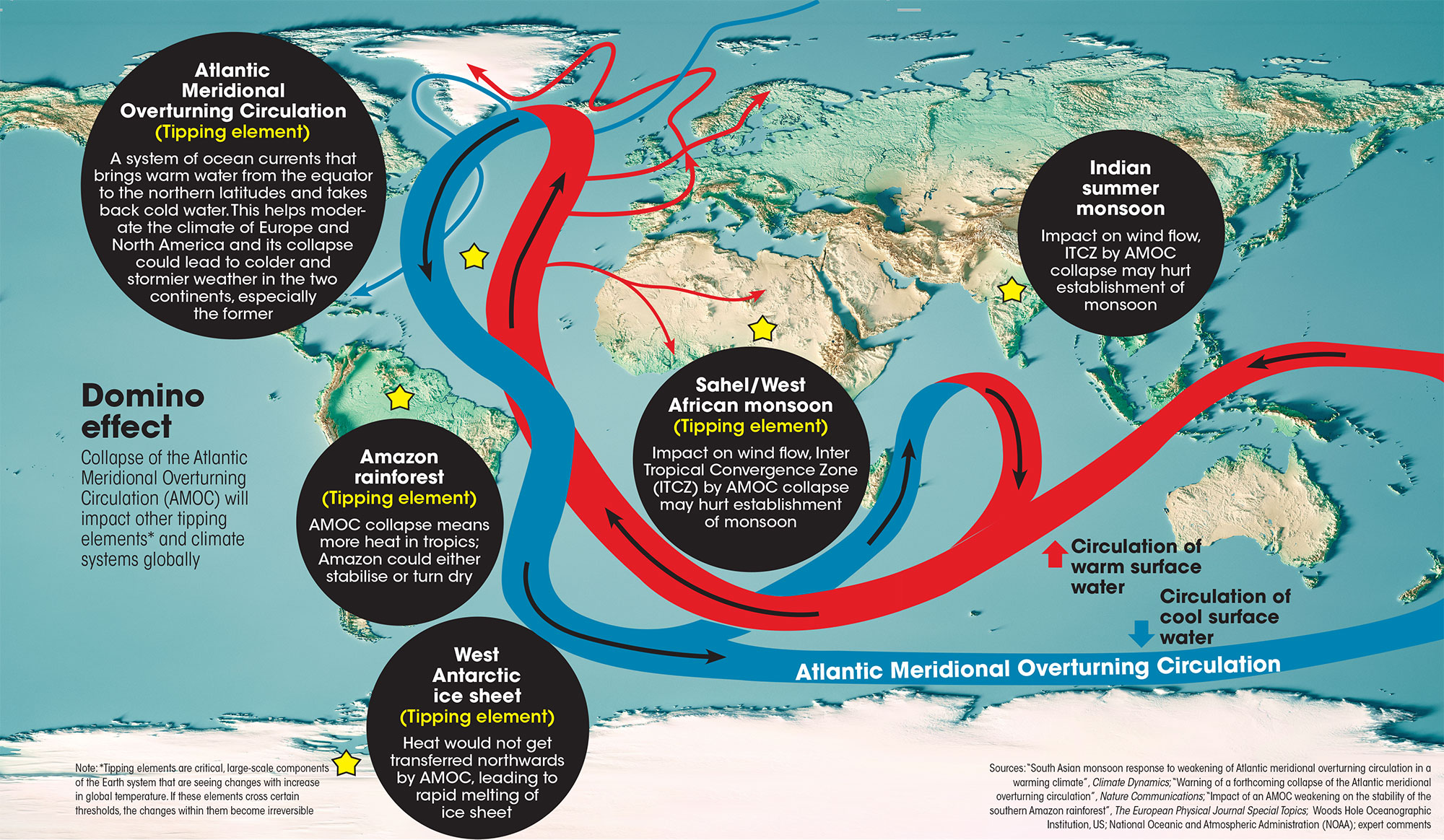
TOPIC – 11 – Foucault’s Pendulum
The pendulum hangs from a skylight at the top of the Constitution Hall at the new Parliament building.
- The original Foucault’s pendulum, named after 19th century French scientist Leon Foucault, is an experiment to demonstrate the earth’s rotation.
- When Foucault carried out this experiment for the public in 1851, it was the first direct visual evidence of the fact that the earth rotates on its axis.
- The experimental set-up involves a heavy object hung from a height with a string, free to swing in any direction.
- Once set in to-and-fro motion, the pendulum is seen to change its orientation slowly over time.
- For example, if the initial motion imparted to it was in the north-south direction, after a few hours it could be seen moving in the east-west direction.
- Actually, it is not the pendulum that changes its plane of motion, but the ground beneath it.
- Observers standing on the ground do not notice the earth’s rotation, because they too are rotating with the earth, but can notice the change in orientation of the pendulum.
Working
- At the north and south poles, when the pendulum is aligned with the axis of rotation of the earth, the pendulum’s back-and-forth motion comes back to its original plane in exactly 24 hours.
- That is, if it starts swinging in the north-south direction, it then slowly turns in the northeast-southwest direction, then in the east-west direction.
- It keeps on changing its orientation, till it is back in its original orientation after 24 hours.
- At other latitudes, it takes longer for the pendulum to return to its original orientation of swinging.
- That is because the pendulum is not aligned with the axis of rotation of the earth.
- At the equator, the pendulum is perpendicular to the axis of rotation, and hence it never changes its orientation of the swing.
- Meaning, a Foucault’s pendulum at the equator would not show any deviation from its original course.
- At other latitudes it will, and would return to the original course after fixed time periods.
India
- The pendulum signifies the integration of the idea of India with the idea of the cosmos.
- Created by the National Council of Science Museum (NCSM) in Kolkata, the pendulum is being dubbed as the largest such piece in India, 22 metre in height, and weighing a staggering 36 kg.
- On the ground, a circular installation has been created to allow the pendulum’s movement.
- At the latitude of the Parliament, it takes 49 hours, 59 minutes, and 18 seconds for the pendulum to complete one rotation.
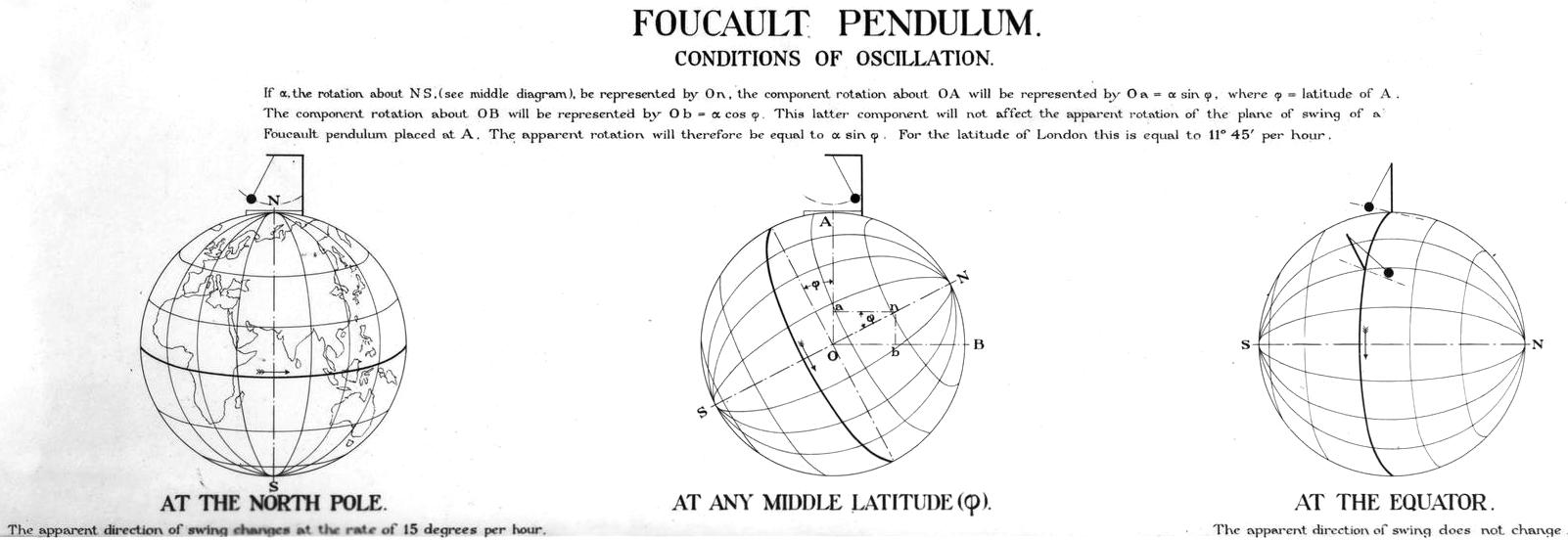
TOPIC – 12 – Evergreening of Loans
The RBI issues a warning against “evergreening” loans, when banks employ cutting-edge techniques to hide the true situation of stressed loans.
About
What does evergreening of loans mean?
- The process of evergreening of loans, a form of zombie lending, is a temporary fix for a bank.
- If an account turns into a non-performing asset (NPA), banks are required to make higher provisions which will impact their profitability.
- To avoid classifying a loan as an NPA, banks adopt the evergreening of loans, which is essentially the rolling over of debts of unviable borrowers that would have otherwise defaulted.
- This is a form of misgovernance, as bad loans are made to look good many a time by additional lending to troubled borrowers.
When do banks evergreen loans?
- Restructuring is often used by banks to ‘evergreen‘ problem accounts to keep reported NPA levels low.
- This was allowed between 2000 and 2014, but with the enactment of the bankruptcy code, evergreening has declined.
- An accommodative monetary policy creates an enabling environment for weak banks to evergreen loans to zombies, leading to a jump in NPAs.
What is the main Concern?
- The process of evergreening of loans, a form of zombie lending, is typically a temporary fix for a bank. If an account turns into a non-performing asset (NPA), banks are required to make higher provisions which will impact their profitability.
How can evergreening be stopped?
- The primary defence against evergreening in a bank must come from the CEO, audit committee and board.
- If significant evergreening is detected by RBI supervisors, penalties should be levied through cancellations of stock options and claw-back of bonuses, and the Chairman of the audit committee should step down from the board.
TOPIC – 13 – History of insurgency in Manipur
According to the Manipuri government, security forces recently killed 40 insurgents.
About
History of conflict in Manipur
- Naga National Movement: Manipur has been in the cross-currents of India’s oldest insurgent movements, such as the Naga national movement in the 1950s and the fight for an independent Nagalim.
- In 1964, the United National Liberation Front (UNLF) was formed, demanding secession from India.
- Meitei insurgent groups: Subsequently, numerous Meitei insurgent groups, such as the People’s Revolutionary Party of Kangleipak (PREPAK) and the People’s Liberation Army (PLA), came into being.
- Conflict between Meiteis and Meitei Pangals (Muslims): At the same time, similar clashes were taking place between the Meiteis and Meitei Pangals (Muslims), leading to the formation of the Islamist group People’s United Liberation Front, alongside several others.
- Kuki-Zomi insurgent groups: The Kuki-Zomi movement started as defence against aggression by other groups, but quickly morphed into a call for Kukiland – an imagined country spreading across the Kuki-Zomi inhabited areas of India, Myanmar and Bangladesh.
- The groups were a reaction to Naga aggression against the Kukis, and in 1993, a massacre of Kukis by the NSCN-IM left thousands of Kukis homeless.
- The primary groups in the area include the Kuki National Organisation and its armed wing, the Kuki Revolutionary Army, the Zomi Re-Unification Organisation, Zomi Revolutionary Army, the Kuki National Front, the Kuki National Liberation Front, United Kuki Liberation Front and Kuki National Army.
Steps taken by the Government in this regard:
- Enactment of AFSPA: The Indian government enacted the Armed Forces Special Powers Act in 1958 in response to Naga separatist activity.
- It was extended to the entire state in the 1980s, and peace talks led to a tripartite Suspension of Operation agreement between the Centre, the state and the Kuki-Zomi groups in 2008.
- However, the Valley Insurgent Groups have never entered an agreement with the Centre or participated in any peace talks, and technically remain active.
- At present, these groups are no longer active in the region.
|
In order to strengthen defence cooperation between India and ASEAN (Association of South East Asian Nations), India would launch an initiative on “women in United Nations Peacekeeping (UNPK) operations.”
Key Highlights
- On the occasion of the 75th United Nations Peacekeepers Day, India, one of the top troop contributors to UNPK, currently has roughly 5,900 troops deployed in 12 U.N. Missions.
- On this day in 1948, the first United Nations peacekeeping mission, the “UN Truce Supervision Organisation,” commenced operations in Palestine.
- One of the efforts under the ‘India-ASEAN Initiative for Women in UNPK Operations is the conduct of tailor-made training at the Centre for United Nations Peacekeeping (CUNPK) in India for women peacekeepers from ASEAN member states.
- In total, 20 peacekeepers would be trained, two from each country. The other is a ‘Table Top Exercise‘ for ASEAN women officers combining aspects of UNPK issues, which will be held in December.
India and UN Peacekeeping Missions:
- India has contributed approximately 2,75,000 troops to peacekeeping missions so far and 159 Indian Army soldiers have lost their lives across the globe.
- The day was commemorated by paying homage to the fallen soldiers by laying a wreath at National War Memorial.
- Indian Armed forces Deployment: Apart from the current deployment, India has pledged one Infantry Battalion Group and a Navy Corvette with Helicopter, as hard power and an Engineer Company and Signal Company as Force enablers, to be deployed at the behest of the U.N.
- Joint Training: In 2016, India and the U.S. had begun an annual training programme for joint training of U.N. peacekeepers from African countries. Three iterations of the joint training were held before it was interrupted due to COVID-19 and a revamped programme was launched in 2021 of which two iterations have been held so far.
- Training for peacekeeping operations: Indian Army has established a Centre for United Nations Peacekeeping (CUNPK) in New Delhi to impart training in peacekeeping operations and the Centre trains more than 12,000 troops every year.
- The centre also hosts foreign delegations as part of sharing best practices and also regularly dispatches mobile training teams to Friendly Foreign Countries as part of capacity building in the field of UNPK.
Deployment of Women Military officials:
- India has deployed Female Engagement Teams in United Nations Organization Stabilization Mission in the Democratic Republic of the Congo and United Nations Interim Security Force for Abyei, which is the second largest women contingent after Liberia.
- India has also deployed Women Military Police in United Nations Disengagement Observer Force and women staff officers and military observers in various missions.





